
CHAMPIONSHIP PLAYOFF FINAL, MAY 24 2025
Mayenda (76)
Watson (90+5)
Campbell (25)
Sunderland’s playoff final comeback against Sheffield United secured their promotion back to the Premier League after an eight-year absence. Régis Le Bris’ side had to hang on for long spells against a Blades team that had finished 14 points ahead of them in the Championship table. But teenage substitute Tommy Watson scored the decisive goal in added time, to send the Sunderland fans into raptures at Wembley Stadium.
Tyrese Campbell gave Sheffield United a first-half lead and, with Sunderland on the ropes at times, it looked like they would add to it. Indeed, they thought they had a second, only for the VAR to rule out a Harrison Burrows effort for offside. Then Eliezer Mayenda’s rocket into the roof of the net on 76 minutes sowed the seeds of belief for Sunderland.
With four seasons in the third-tier fresh in Mackem memories, plus a Championship playoff defeat two years ago, they can now prepare for life in the top flight. Their French head coach Le Bris, meanwhile, can reflect on a highly successful first season in English football.
How the managers saw it
“It was a weird game,” said Le Bris. “We didn’t start it well, we were maybe a bit nervous. We knew before they could be clinical and they were; we were lucky because we had many options on the bench. We tried two or three different options and finally we found the solution. The players found the solution.”
“We just needed to be better on that turnover,” said Chris Wilder. “But we didn’t get the balance right in terms of when they put a screener in to screen Kieffer [Moore] and play out from the back. The biggest thing for us was that we were too loose in the second half. We have the ability to sit in while they’re piling people forward, and hit them on the counter-attack – but we never found that moment. We were loose.”
Below, UEFA-licensed coaches from Coaches’ Voice have analysed the tactical highlights from a dramatic playoff final.
 13135321474111228124151914742218923
131353214741112281241519147422189239/3
SHOTS / ON TARGET
7/3
59%
POSSESSION
41%
24
ATTACKS INTO AREA
14
0.53
EXPECTED GOALS (XG)
1.05
Attacking the 4-4-2 blocks
In the first half, Sheffield United left-back Burrows advanced high up the pitch when his team attacked Sunderland’s 4-4-2 block. By taking his direct opponent Chris Rigg with him, he created extra time and space for left centre-back Jack Robinson to step into midfield. The latter could then pick out forward passes, until eventually he was pressed by Enzo Le Fée. Burrows also worked well with left midfielder Gustavo Hamer, who offered wide when the full-back underlapped and vice versa. By contrast, United’s other full-back, Hamza Choudhury, barely advanced (below).
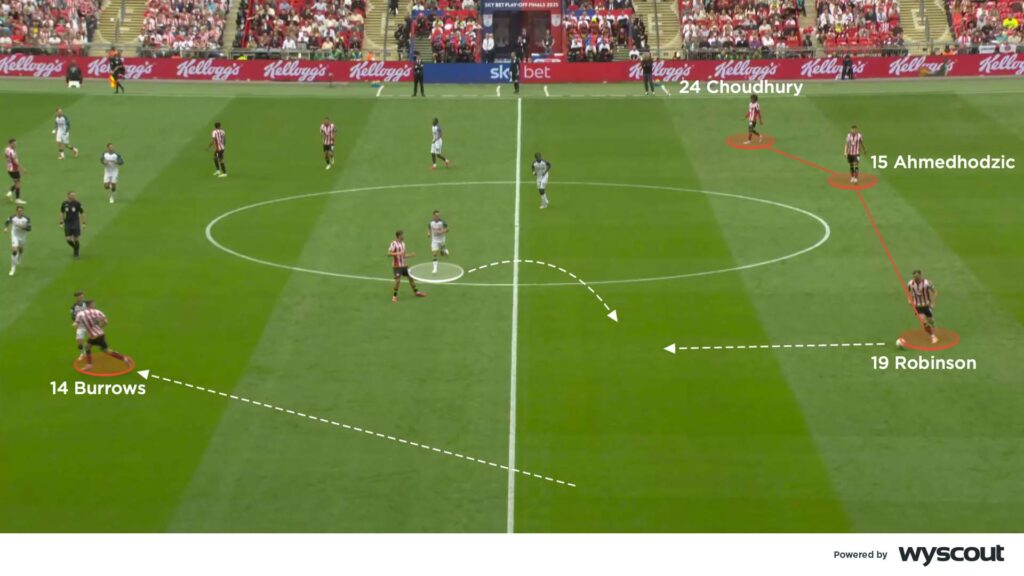
For United’s pinpoint longer passes into the front line – including passes from Robinson – Moore was the natural target. The number nine’s aerial duelling caused Sunderland’s back line significant problems in the first half. Hamer, meanwhile, narrowed from left midfield, ready to support underneath the front line while also creating space for Burrows to overlap from deep (below). The directness of Wilder’s team was evident in the opening goal, counter-attacking from defending a corner, with Tyreese Campbell finishing well in a 1v1.
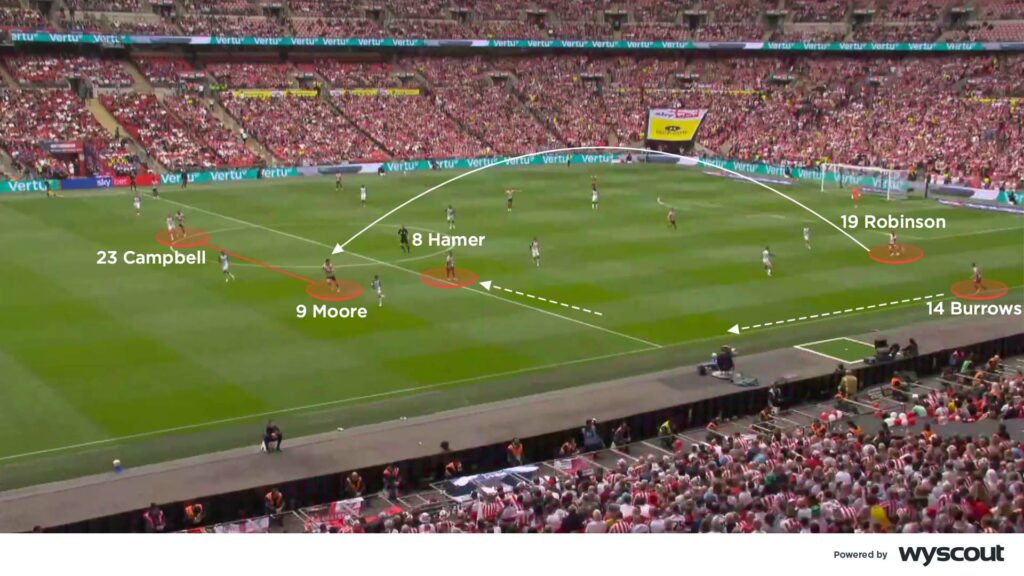
Sunderland also pushed their full-backs high when attacking – initially right-back Trai Hume. His runs forward worked off Rigg’s movement inside and dragged Hamer into deeper defensive positions, reducing his notable attacking threat. The double pivot of Jobe Bellingham and Dan Neil supported underneath the full-back advances. Further forward, number 10 Le Fée floated between the lines, looking to receive and connect with single centre-forward Mayenda (below), but he struggled to work within United’s compact block.

Left-back Dennis Cirkin advanced from the back line more as the first-half progressed. His diagonal runs inside drew his marker, freeing up a wide pass to winger Romaine Mundle (below).
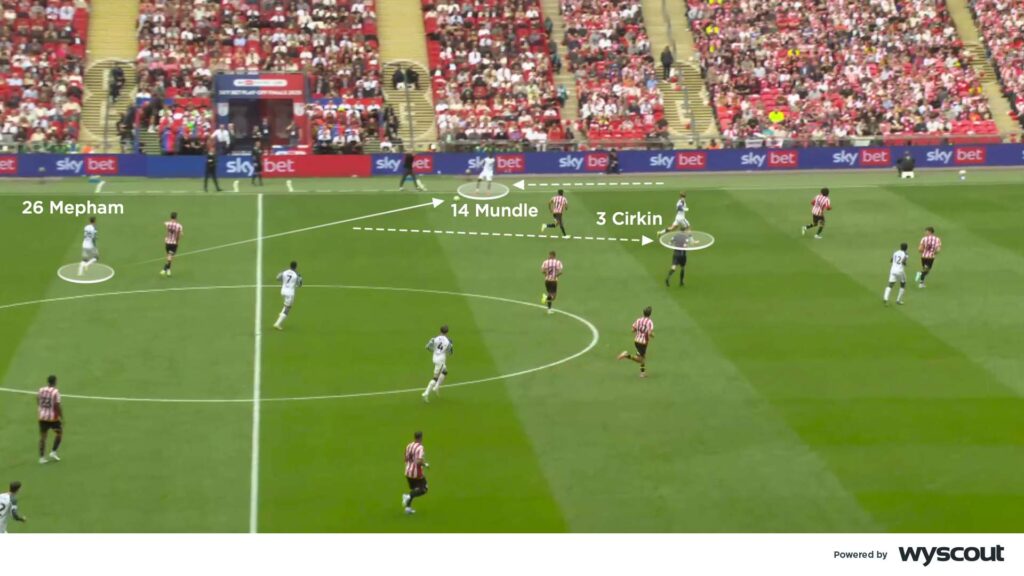
But with Sunderland attacking more often with shorter passes than their opponents, they took much longer to reach the final third. By the time they got there, Sheffield United’s 4-4-2 block had narrowed and protected the central areas. Sunderland began to dominate possession, but without much presence to attack crosses they created few chances.
Sunderland’s attacking tweaks
Le Bris made various attacking changes in the second half to try and get his team back in the game. First he shifted Sunderland to a 4-3-3 when attacking, with Bellingham released to work higher alongside Le Fée (below). Sunderland also attacked with quicker passes, finding their number eights and front line with purpose. Their shift in midfield stretched United’s two central midfielders, with Mundle subsequently getting regular 1v1s against Choudhury on the left. A winger was missing on Sunderland’s right side, however, until Patrick Roberts was added for Rigg on 58 minutes. That meant they could then attack both full-backs.
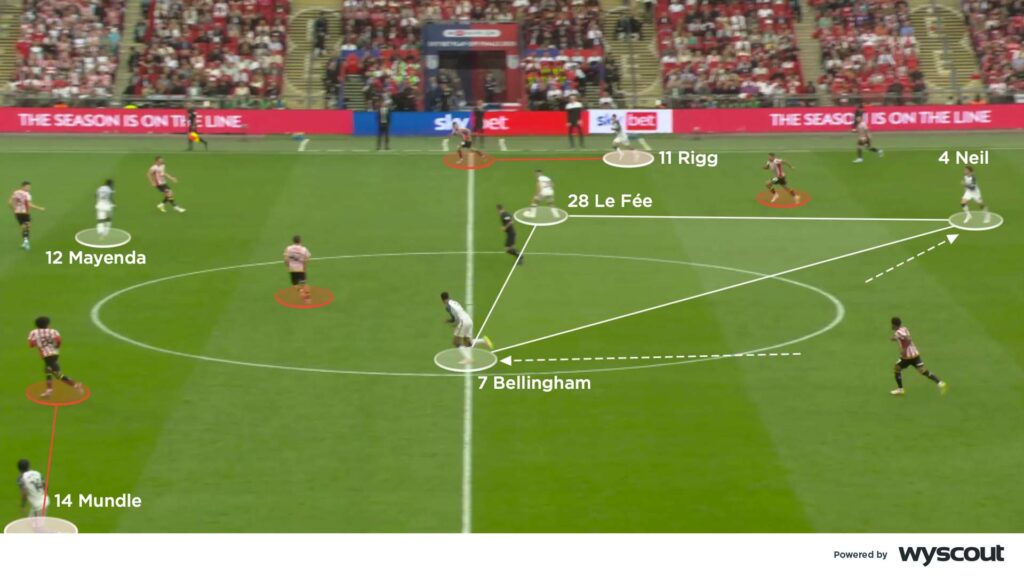
Sunderland remained consistently fluid on their left whatever their tactical shape. Mundle and Cirkin connected well in the final third, looking to combine with central teammates wherever possible, and no longer swinging in hopeful crosses. Sheffield United’s block was well organised, though. Even the front pair worked back to defend spaces in and around the penalty area (below). This limited their own attacking output, but frustrated Sunderland for a time, despite the Black Cats’ quickened possession.
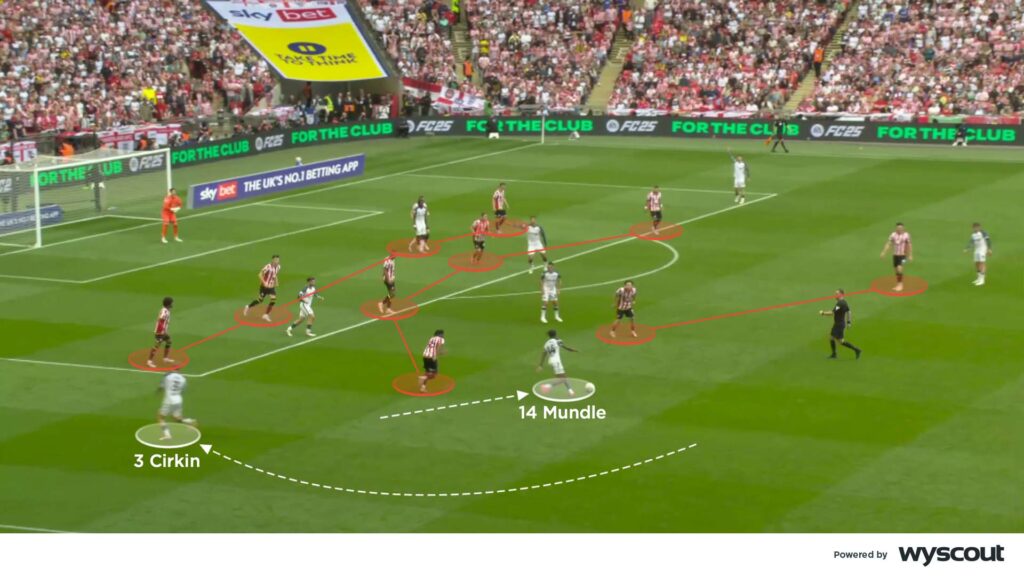
Le Bris responded by moving Sunderland to a 4-4-2, with two centre-forwards on the pitch for the first time. Wilson Isidor replaced Mundle, with Watson added to the left and Le Fée dropping back alongside Bellingham, in place of Neil. This gave Sunderland an all-out attack in the central areas – Roberts and Watson moving inside to support where possible, linking nicely with the forward passing of the central midfield. Isidor and Mayenda occupied both of United’s centre-backs, with Sunderland able to attack the middle of the pitch and the heart of United’s back line (below).
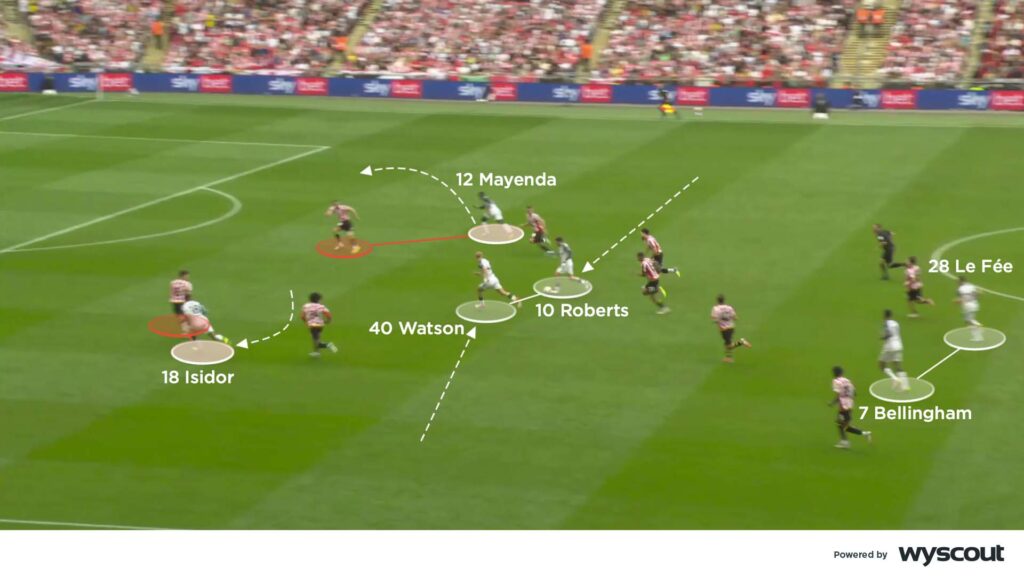
Mayenda’s powerful strike levelled things soon after Le Bris’ final attacking tweaks. The Spanish forward and Sunderland were no strangers to late goals, having netted an 88th-minute winner in the semi final first leg at Coventry. In the second leg Dan Ballard scored in added time of extra-time to send Sunderland to Wembley. And on the big stage they did it once again, as Watson landed the killer blow deep into added time.
To learn more about football tactics and gain insights from coaches at the top of the game, visit CV Academy



